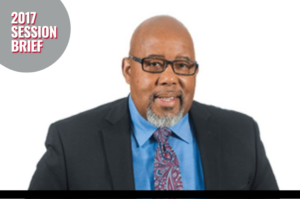By Sydney Shadrix
 “All I wanted was a box of Cracker Jacks.”
“All I wanted was a box of Cracker Jacks.”
Then an eight-year-old boy, Greg Townsend remembers taking his 25 cents to the neighborhood corner store, which sat on the dividing line of the black community and the white community in Birmingham, Alabama. Like many stores in the 1960s segregated South, one side of the store was designated for white customers; the other for colored customers. On this day, the division presented a problem for Townsend — only the white side had Cracker Jacks.
Townsend, who now serves as the health services administrator for the Jefferson County Department of Health in Birmingham, Alabama, was determined to get his treat.
“Being the man that I am—the young boy that I was—I walked over to the white side of the store to get my box of Cracker Jacks,” Townsend said. “They told me as I was leaving, ‘You people — your people — shop on the other side of the store. You don’t come on this side.’ But, I still got my box of Cracker Jacks.”
Stores may no longer be overtly segregated, but for many in Jefferson County today, the impact of racial and ethnic divisions are reflected in access to quality health services.
“There are still people — still communities — searching for their box of Cracker Jacks,” Townsend told attendees at the State of the Public’s Health Conference in Athens, Georgia on October 17.
Health equity means that everyone has a fair opportunity to live a long and healthy life. Unfortunately, Townsend explained, that is not the case in Jefferson County.
Single-parent households make up almost of a quarter of all households, and 26.3 percent of children are living in poverty. For every unemployed white person, two African Americans are unemployed. The infant mortality rate for African Americans is nearly three times higher compared to whites in Jefferson County.
Statistics like these illustrate how social determinants matter, Townsend said. “There is a 10-year difference in quality of life because of poverty and all of the other issues that we have,” Townsend said. “Ten years.”
To take on health disparities, communities must work together to address the divide. Better health can be achieved by promoting physical activity, creating a built environment, optimizing healthcare access, and improving mental health.
Yet, these goals cannot be accomplished by one person or by one health department.
Townsend suggested six principles for advancing health equity, which emphasize the importance of bringing community voices — those who have been negatively impacted by health disparities — to the table to develop, implement and evaluate new programs. in the development, implementation, and evaluation of new programs.
‘The time is now,” Townsend said. “We work in healthcare. We take care of people- from the wealthiest to the least, from the 99 percent to the one percent. The time is now for us in healthcare to take the leap if we’re going to create a health equity movement.”
